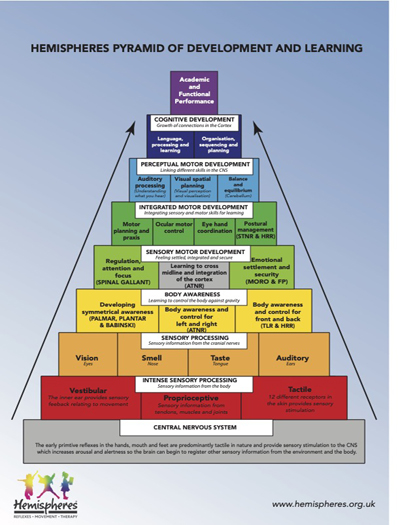Reflexes
What are the Primitive and Postural Reflexes?
These are naturally occurring patterns of movement which are present in all children from birth, they are controlled by the lower part of the brain, the Brainstem, and produce involuntary patterns of movement.
Regular stimulation of the reflexes in early development will facilitate the development of the neurological pathways into the higher centers of the brain which in turn enables a child to develop movements which they can direct and control. The continual stimulation will enable functional skills to begin, evolve and mature. The primitive reflexes are expected to be inactive or inhibited within the CNS between 12 months and 3 years of age, and at the same time enable functional skills to emerge and develop in line with their chronological age. When the reflexes remain active beyond these age limits, they are classified as retained, and retained reflexes can have a disrupting influence on the development of the neurological connections causing symptoms with sensory processing, integration of thought and action, cause interruption to the development of coordination, focus and concentration as well as integration of emotional responses. The reflexes in fact set up the CNS and play a significant role in establishing the integration for function and learning. As the reflexes are part of the natural order of development, if they are retained, they can and do respond to a programme of movement which stimulates the immature reflex to develop and inhibit.
At Hemispheres we assess for both the sensory trigger or stimulation of the reflexes as well as the functional outcome so we can identify any immaturity in the different levels of control and direct specific movements and activities to inhibit the immature reflexes.
How do the reflexes work?
The reflexes are the way in which our CNS is stimulated and facilitates the development the neuronal connections from the body to the brain. This gives rise to the development of specific parts of the brain which then produce voluntary control of the body. This bottom up (body to brain) and top down (brain to body) processing is an essential relay of information which enables a child to develop the skills they need for movement, vision, auditory, emotion, social participation, understanding, comprehension, learning and functional development. As the CNS matures it builds specific skills in different parts of the brain, which then need to integrate together, and therefore the final level of integration is left to right control and connections between the two sides of the brain. This is essential for academic, social and motor development. If the reflexes do not integrate effectively, they cause disruption in the CNS and this in turn means the sensory information cannot be proceeded accurately, contributing to emotional, sensory and behavioural difficulties.

Copyright © 2024 | Privacy Policy


